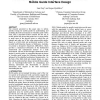Free Online Productivity Tools
i2Speak
i2Symbol
i2OCR
iTex2Img
iWeb2Print
iWeb2Shot
i2Type
iPdf2Split
iPdf2Merge
i2Bopomofo
i2Arabic
i2Style
i2Image
i2PDF
iLatex2Rtf
Sci2ools
BEHAVIOURIT
2005
2005
Understanding and modelling built environments for mobile guide interface design
The research presented in this paper aims to inform interface design for mobile guides by understanding and modelling the built environments in which the guide will be used. This is important because research into the use of mobile guides has shown that people have a strong ability to make sense of the physical space in which they are situated and make use of this when using mobile guides. Based on a field study and architectural analysis of the recently built Federation Square in Melbourne, Australia, we present a descriptive framework, MIRANDA, which a summarized abstraction of the fundamental architectural and informational features of a built environment. The use of this descriptive framework in HCI design for mobile guides is exemplified through the design of a mobile guide system for Federation Square that was informed by the identified architectural characteristics. On the basis of the field study and example design, we argue that mobile guides interface design can benefit from...
| Added | 15 Dec 2010 |
| Updated | 15 Dec 2010 |
| Type | Journal |
| Year | 2005 |
| Where | BEHAVIOURIT |
| Authors | Jeni Paay, Jesper Kjeldskov |
Comments (0)

